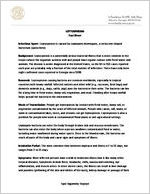LEPTOSPIROSIS Fact Sheet
Infectious Agent: Leptospirosis is caused by Leptospira interrogans, a corkscrew-shaped bacterium (spirochete).
Background: Leptospirosis is a potentially serious bacterial illness that is most common in the tropics where the organism survives well and people have regular contact with fresh water and animals. The disease is under-diagnosed in the United States, so the 50 to 150 cases reported each year are probably only a fraction of the total number of infections. There have only been eight confirmed cases reported in Georgia since 1988.
Reservoir: Leptospirosis-causing bacteria are common worldwide, especially in tropical countries with heavy rainfall. Infected rodents and other wild (e.g., raccoons, feral hogs) and domestic animals (e.g., dogs, cattle, pigs) pass the bacteria in their urine. The bacteria can live for a long time in fresh water, damp soil, vegetation, and mud. Flooding after heavy rainfall helps spread the bacteria in the environment.
Mode of Transmission: People get leptospirosis by contact with fresh water, damp soil, or vegetation contaminated by the urine of infected animals. People who canoe, raft, wade, or swim in contaminated lakes, rivers, and streams can get leptospirosis. Leptospirosis is also a problem for people who work in contaminated flood plains or wet agricultural settings.
Leptospira bacteria can enter the body through broken skin and mucous membranes. The bacteria can also enter the body when a person swallows contaminated food or water, including water swallowed during water sports. Once in the bloodstream, the bacteria can reach all parts of the body and cause signs and symptoms of illness.
Incubation Period: The most common time between exposure and illness is 7 to 10 days, but ranges from 2 to 21 days.
Symptoms: Most infected persons have a mild to moderate illness that is like many other tropical diseases. Symptoms include fever, headache, chills, nausea and vomiting, eye inflammation, and muscle aches. In more severe cases, the illness can result in liver damage and jaundice (yellowing of the skin and whites of the eyes), kidney damage or passage of dark
Equal Opportunity Employer
February 24, 2012 Page 2
urine, and internal bleeding. People who are seriously ill with leptospirosis often need to be hospitalized. Severe or untreated leptospirosis can lead to organ system damage and, in rare cases, death.
Diagnostic Testing: A. Culture or PCR 1. From blood in first 7 days of acute infection 2. From urine after 10th day of infection 3. Bacteriology Laboratory, Georgia Public Health Laboratory (GPHL) in Decatur B. Serology 1. Microscopic Agglutination Titers (MAT) 2. IgM ELISA 3. LEPTO Dipstick 4. GPHL will coordinate submission of serologic samples to CDC C. Urine Antigen Test: demonstration of Leptospira bacteria by immunofluorescence
Laboratory Criteria for Diagnosis: Presumptive:
A positive result on LEPTO Dipstick, or Leptospira agglutinatin titer greater than 200
Confirmatory: Isolation of Leptospira from a clinical specimen, or Fourfold or greater increase in Leptospira serology titer between serum specimens obtained greater than or equal to 2 weeks apart and studied at the same laboratory, or Demonstration of Leptospira in a clinical specimen by immunofluorescence
Case Classification: Probable: a clinically compatible case with laboratory results indicative of presumptive infection Confirmed: a clinically compatible case with confirmatory laboratory results
Treatment: Leptospirosis is treatable with antibiotics. Treatment should be started as soon as possible to be most effective. Severely ill persons might need intravenous antibiotic treatment and other supportive care.
February 24, 2012 Page 3
Reporting: Report all cases within 7 days to the local health department, District Health Office, or the Epidemiology Branch at 404-657-2588. Diagnostic support for suspect cases can be provided by the Georgia Public Health Laboratory. Please call any of the entities above to arrange for testing.
Links: CDC - http://www.cdc.gov/leptospirosis/index.html
http://www.bt.cdc.gov/disasters/disease/leptoclin.asp
The Leptospirosis Information Center http://www.leptospirosis.org/
World Health Organization - http://www.who.int/topics/leptospirosis/en/
